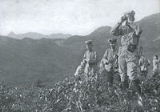
Battle of Liaoyang
Encyclopedia
The Battle of Liaoyang (Japanese: 遼陽会戦 Ryōyō kaisen) (24 August - 4 September 1904) was one of the major land battles of the Russo-Japanese War
.
While the Japanese Army
settled down in front of Port Arthur
for a siege
, a large force under Field Marshal Oyama
moved north to secure the strategically located rail junction of Liaoyang
, on the Mukden–Port Arthur spur of the China Far East Railway
, in Manchuria
.
The battle began on 25 August 1904, with the 158,000 strong Russian armies, attempting to turn the flanks of the Japanese First, Second and Third Armies totaling 125,000 men.
On 26 August 1904, the Japanese First Army took Kosarei Peak and Hung-sha Pass southeast of Liaoyang city after a hard-fought action. General Alexei Kuropatkin, commander-in-chief
of the Russian armies, believed that he had been beaten and withdrew from the outer Russian defense line, with the Japanese in pursuit.
From 29–30 August 1904, the Russian troops managed to repel intense Japanese assaults on the main defense lines south of Liaoyang. By 31 August 1904, the Japanese First Army was crossing the river northeast of Liaoyang,
On 4 September 1904, after a few days of ineffectual counterattacks, Kuropatkin decided to evacuate Liaoyang for Mukden in the early morning. The unfortunate city was then sacked in succession by Russian, Chinese, and Japanese forces.
The Russian armies suffered about 17,900 casualties, the majority of which were captured or missing. However, despite the greater Japanese casualties (23,615 killed, wounded or captured), the Japanese were able to claim victory since the Russians quit the battlefield.
The dearly-won Japanese victory at Liaoyang
and the fall of Port Arthur shortly thereafter contributed to the major Russian defeat the next year at the Battle of Mukden
.
Russo-Japanese War
The Russo-Japanese War was "the first great war of the 20th century." It grew out of rival imperial ambitions of the Russian Empire and Japanese Empire over Manchuria and Korea...
.
While the Japanese Army
Imperial Japanese Army
-Foundation:During the Meiji Restoration, the military forces loyal to the Emperor were samurai drawn primarily from the loyalist feudal domains of Satsuma and Chōshū...
settled down in front of Port Arthur
Lüshunkou
Lüshunkou is a district in the municipality of Dalian, Liaoning province, China. Also called Lüshun City or Lüshun Port, it was formerly known as both Port Arthur and Ryojun....
for a siege
Siege
A siege is a military blockade of a city or fortress with the intent of conquering by attrition or assault. The term derives from sedere, Latin for "to sit". Generally speaking, siege warfare is a form of constant, low intensity conflict characterized by one party holding a strong, static...
, a large force under Field Marshal Oyama
Oyama Iwao
|-...
moved north to secure the strategically located rail junction of Liaoyang
Liaoyang
Liaoyang is a city in China, Liaoning province, located in the middle of the Liaodong Peninsula. The city is situated on the T'ai-tzu River and forms with Anshan a built up area of 2,057,200 inhabitants in 2010....
, on the Mukden–Port Arthur spur of the China Far East Railway
China Far East Railway
The Chinese Eastern Railway or was a railway in northeastern China . It connected Chita and the Russian Far East. English-speakers have sometimes referred to this line as the Manchurian Railway...
, in Manchuria
Manchuria
Manchuria is a historical name given to a large geographic region in northeast Asia. Depending on the definition of its extent, Manchuria usually falls entirely within the People's Republic of China, or is sometimes divided between China and Russia. The region is commonly referred to as Northeast...
.
The battle began on 25 August 1904, with the 158,000 strong Russian armies, attempting to turn the flanks of the Japanese First, Second and Third Armies totaling 125,000 men.
On 26 August 1904, the Japanese First Army took Kosarei Peak and Hung-sha Pass southeast of Liaoyang city after a hard-fought action. General Alexei Kuropatkin, commander-in-chief
Commander-in-Chief
A commander-in-chief is the commander of a nation's military forces or significant element of those forces. In the latter case, the force element may be defined as those forces within a particular region or those forces which are associated by function. As a practical term it refers to the military...
of the Russian armies, believed that he had been beaten and withdrew from the outer Russian defense line, with the Japanese in pursuit.
From 29–30 August 1904, the Russian troops managed to repel intense Japanese assaults on the main defense lines south of Liaoyang. By 31 August 1904, the Japanese First Army was crossing the river northeast of Liaoyang,
On 4 September 1904, after a few days of ineffectual counterattacks, Kuropatkin decided to evacuate Liaoyang for Mukden in the early morning. The unfortunate city was then sacked in succession by Russian, Chinese, and Japanese forces.
The Russian armies suffered about 17,900 casualties, the majority of which were captured or missing. However, despite the greater Japanese casualties (23,615 killed, wounded or captured), the Japanese were able to claim victory since the Russians quit the battlefield.
The dearly-won Japanese victory at Liaoyang
Liaoyang
Liaoyang is a city in China, Liaoning province, located in the middle of the Liaodong Peninsula. The city is situated on the T'ai-tzu River and forms with Anshan a built up area of 2,057,200 inhabitants in 2010....
and the fall of Port Arthur shortly thereafter contributed to the major Russian defeat the next year at the Battle of Mukden
Battle of Mukden
One of the largest land battles to be fought before World War I, the , the last major land battle of the Russo-Japanese War, was fought from 20 February to 10 March 1905 between Japan and Russia near Mukden in Manchuria...
.

